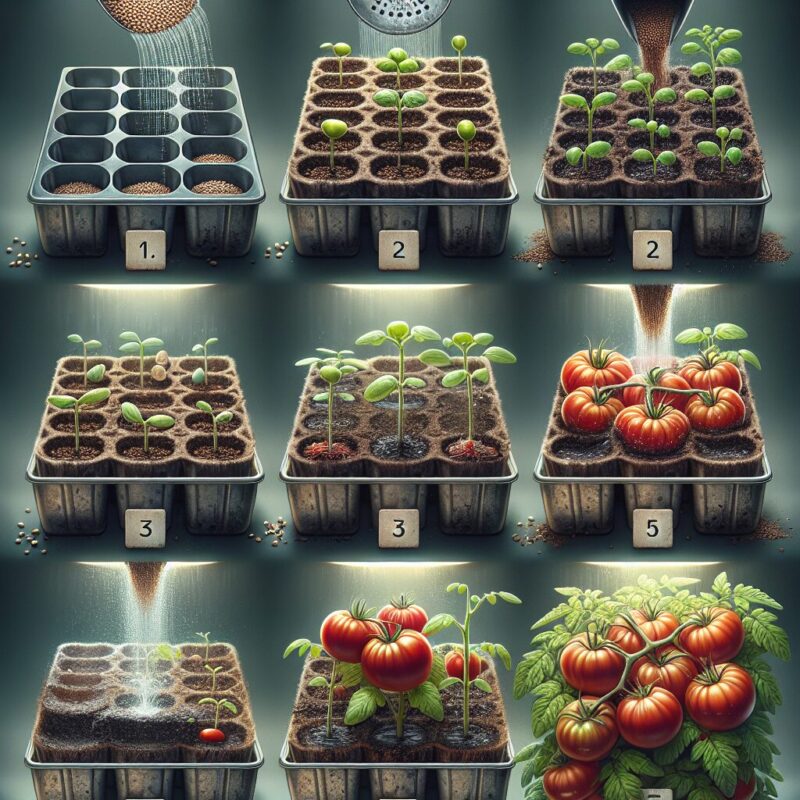San Marzano tomatoes, also known as the “queen of Italian tomatoes,” are a type of plum tomato that originated in the San Marzano region of Italy. Renowned for their rich flavor, low acidity, and firm texture, these tomatoes have become a favorite among gardeners and home cooks alike. With their distinctive elongated shape and deep red color, San Marzano tomatoes are not only a delight to the eyes but also offer a plethora of culinary possibilities.
When it comes to planting San Marzano tomatoes, there are a few important considerations to keep in mind. These tomatoes thrive in warm climates with plenty of sunlight, making them an excellent choice for gardeners in Mediterranean-like regions. Their vigorous growth habit and resistance to diseases make them a relatively low-maintenance crop. However, they do require consistent watering and well-drained soil to prevent root rot and fungal diseases. Additionally, proper spacing and support systems, such as stakes or cages, are crucial to ensure the plants have enough room to grow and produce an abundant harvest.
In the upcoming sections, we will delve deeper into the key aspects of planting San Marzano tomatoes. We will discuss the ideal soil conditions for these tomatoes, the best time to sow the seeds or transplant seedlings, and essential tips for nurturing their growth. Furthermore, we will explore effective pest and disease management strategies to help you maintain healthy tomato plants throughout the growing season. So, if you’re eager to embark on a tomato-growing journey or looking to enhance your existing San Marzano crop, stay tuned for valuable insights and actionable advice.
Key Takeaways
1. Choose the right location: Plant your San Marzano tomatoes in a spot that receives at least 6-8 hours of sunlight per day and has well-draining soil. Avoid areas prone to standing water or strong winds.
2. Prepare the soil: Before planting, amend the soil with organic matter to improve its structure and fertility. San Marzano tomatoes prefer slightly acidic soil with a pH level between 6.0 and 6.8.
3. Planting techniques: Dig a hole slightly larger than the root ball and place the tomato plant in it, ensuring that the top of the root ball is level with or slightly above the soil surface. Space the plants 24-36 inches apart to allow for proper air circulation and growth.
4. Provide support: San Marzano tomato plants are indeterminate and will continue growing throughout the season. Stakes, cages, or trellises should be installed at planting time to support the plants and prevent them from sprawling on the ground.
5. Watering and care: Water regularly, providing deep and thorough watering rather than frequent shallow watering. Mulching around the plants helps retain moisture and reduce weed growth. Regularly monitor for pests and diseases, and offer appropriate care such as pruning and fertilizing to ensure healthy growth and fruit production.
How to Successfully Plant San Marzano Tomatoes
Choosing the Right Location
When it comes to planting San Marzano tomatoes, selecting the perfect location is crucial for their growth and productivity. Consider the following factors:
Sunlight
San Marzano tomatoes thrive in full sunlight, so choose a spot in your garden that receives at least 6-8 hours of direct sunlight per day. This will ensure optimal growth and a bountiful harvest.
Soil Quality
Ensure that the soil in your chosen spot is well-draining and rich in nutrients. San Marzano tomatoes prefer loamy soil with a pH level around 6.0-6.5. If your soil is heavy or clay-like, consider amending it with organic matter such as compost or well-rotted manure to improve its texture and fertility.
Preparing the Soil
Before planting, it’s crucial to prepare the soil properly to create an ideal growing environment for your San Marzano tomatoes. Follow these steps:
Clear the Area
Remove any weeds or debris from the planting area to prevent competition for nutrients and reduce the risk of pests and diseases.
Add Organic Matter
Mix in organic matter such as compost or aged manure into the soil to improve its structure, fertility, and water-holding capacity.
Test Soil pH
Use a soil testing kit or take a sample to a local agricultural extension service to determine the pH level of your soil. Adjust it if necessary by adding lime to increase pH or sulfur to decrease it, ensuring it falls within the recommended range (6.0-6.5) for San Marzano tomatoes.
Planting the San Marzano Tomato Seedlings
Now that you have chosen the ideal location and prepared the soil, it’s time to plant your San Marzano tomato seedlings. Follow these guidelines:
Timing
Wait until all chances of frost have passed before planting your San Marzano tomato seedlings. The soil temperature should also be consistently above 60°F (15°C) for optimal growth.
Spacing
Space your tomato plants approximately 24-36 inches (60-90 cm) apart to allow for proper air circulation and prevent the spread of diseases. If you plan on using stakes or cages for support, ensure there is enough space around each plant to accommodate these structures.
Planting Depth
Dig a hole slightly deeper than the length of the plant’s root ball. Gently remove the seedling from its container and place it in the hole, ensuring that the bottom leaves are just above the soil surface. Fill the hole with soil, gently firming it around the base of the plant.
Watering and Mulching
Water your newly planted San Marzano tomatoes thoroughly, ensuring that the soil is evenly moist. Applying a layer of organic mulch around the plants will help retain moisture, suppress weed growth, and regulate soil temperature.
Maintaining and Caring for San Marzano Tomatoes
Proper maintenance and care are essential for the healthy growth and productivity of your San Marzano tomato plants. Consider these key aspects:
Watering
Water your plants regularly, aiming for approximately 1-1.5 inches of water per week. Be sure to water deeply, allowing the water to reach the roots, and avoid overhead watering to minimize the risk of diseases.
Fertilizing
Feed your San Marzano tomatoes with a balanced fertilizer that is high in phosphorus and potassium. Apply the fertilizer according to the package instructions, generally around two to three weeks after planting and again during fruit development.
Supporting
As your San Marzano tomatoes grow, provide support to keep the plants upright and prevent sprawling. You can use stakes, cages, or trellises to support the main stem and secure any side branches that may need reinforcement.
Pruning
Regularly remove any suckers that emerge from the leaf axils of your San Marzano tomato plants. This will redirect the plant’s energy towards fruit production and airflow, reducing the risk of diseases.
Tips for a Successful San Marzano Tomato Harvest
1. How do I know when my San Marzano tomatoes are ripe and ready for harvest?
2. Should I remove any diseased or damaged fruits from my San Marzano tomato plants?
3. What are some common pests and diseases that affect San Marzano tomatoes, and how can I prevent or treat them?
4. Can I save seeds from my San Marzano tomatoes for future planting?
5. How should I store my harvested San Marzano tomatoes to maintain their freshness and flavor?
Frequently Asked Questions
1. Can I plant San Marzano tomatoes in any type of soil?
While San Marzano tomatoes thrive in well-drained soil, they can adapt to various soil types. However, it is crucial to prepare the soil beforehand by incorporating organic matter, such as compost or well-rotted manure, to improve fertility and drainage.
2. Are San Marzano tomatoes suitable for container gardening?
Absolutely! San Marzano tomatoes can be successfully grown in containers. Choose a large pot with drainage holes, and use high-quality potting soil rich in organic matter. Remember to provide support, such as a trellis or stake, to help the plants grow upright.
3. What is the ideal planting time for San Marzano tomatoes?
San Marzano tomatoes are warm-season plants, so it is best to plant them after the danger of frost has passed and the soil temperature has reached around 60°F (15°C). This usually falls in late spring or early summer, depending on your location.
4. How much sunlight do San Marzano tomatoes require?
San Marzano tomatoes are sun-lovers and require at least 6-8 hours of direct sunlight daily to thrive and produce abundant fruit. Choose a sunny spot in your garden or balcony for optimal growth.
5. Should I prune San Marzano tomato plants?
Pruning San Marzano tomato plants is not necessary but can be beneficial. Removing suckers (the small shoots that emerge from leaf axils) can help redirect the plant’s energy towards fruit production, leading to larger and healthier tomatoes. However, be cautious not to overprune, as the plant still needs foliage to provide shade for the fruits.
6. How often should I water San Marzano tomatoes?
San Marzano tomatoes require consistent moisture, especially during the growing season. Water deeply and regularly to keep the soil evenly moist but not waterlogged. Aim for about 1-1.5 inches of water per week, adjusted based on weather conditions.
7. Do San Marzano tomatoes require any fertilization?
To promote healthy growth and optimal fruit production, it is recommended to fertilize San Marzano tomato plants. Use a balanced organic fertilizer or a slow-release granular fertilizer according to package instructions. Avoid excessive nitrogen, as it may lead to excessive foliage growth with fewer fruits.
8. Are San Marzano tomatoes prone to any diseases or pests?
San Marzano tomatoes are generally resistant to many common tomato diseases. However, they can still be susceptible to issues like blossom end rot, which is caused by calcium deficiency. Regular inspection and proper cultural practices, such as providing adequate calcium and airflow, can help prevent and manage potential problems effectively.
9. When are San Marzano tomatoes ready for harvest?
The exact harvesting time can vary depending on the growing conditions and desired ripeness. Generally, San Marzano tomatoes are ready to be picked when they turn deep red and feel firm but slightly yielding to the touch. Harvesting when fully ripe ensures the best flavor and texture.
10. Can I save seeds from San Marzano tomatoes for future planting?
Yes, you can save seeds from ripe San Marzano tomatoes for future planting. Scoop out the seeds, rinse off the gel, and dry them on a paper towel. Once completely dry, store them in a cool, dry place in an airtight container until you are ready to sow them in the following season.
Final Thoughts
Planting San Marzano tomatoes can be a rewarding experience for gardeners and tomato enthusiasts alike. These delicious, meaty tomatoes are not only exquisite for cooking but also a delight to grow. By following the proper planting techniques, providing the right care and attention, you can enjoy a bountiful harvest of San Marzano tomatoes bursting with rich flavors. Whether you are a beginner or an experienced gardener, the journey of cultivating these Italian beauties is sure to bring satisfaction and mouthwatering results to your table.
Remember to stay vigilant against any potential issues that may arise, such as pests or diseases, and take proactive measures to prevent and address them promptly. With a bit of patience, dedication, and green thumbs, you can have a thriving San Marzano tomato garden that will surely impress your taste buds and elevate your culinary creations. Happy gardening!

